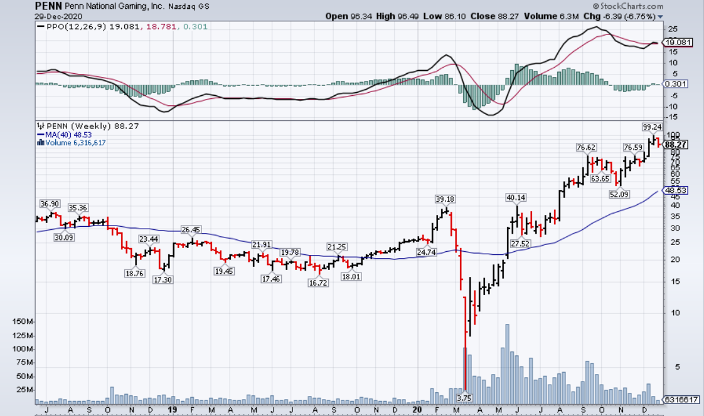Written by Nick Vasco From their February 2020 highs to their March 2020 lows, Penn National Gaming (NASDAQ: PENN) shares lost more than 90% of their value. But less than 10 months later, Penn shares are more than double what they were in February and more than 20x where they were at the March lows.
The recovery seems shocking at first glance. The casino industry was decimated by COVID-19, after all. Companies like Las Vegas Sands (NYSE: LVS) and MGM Resorts (NYSE: MGM) have struggled mightily.

Penn’s Casinos Have Taken Less of a Hit
Penn had an abysmal second quarter, which isn’t too surprising given that Q2 was generally the worst quarter for companies that rely on physical locations. Revenue dipped 77% yoy to just over $300 million and EPS came in at a loss of $1.69 a share vs. a profit of 44 cents a share in the year-ago period.
In Q3, however, Penn’s revenues recorded a massive sequential improvement; at $1.13 billion, they were down just 16.3% yoy. EPS was more impressive – a profit of 93 cents a share, up 144.7% yoy and blowing away consensus estimates of 48 cents a share.
How was Penn able to recover so quickly?
Penn’s casinos are regional, drive-in properties, as opposed to international destinations. This means that customers don’t need to fly to go to Penn’s casinos. A massive advantage in the midst of the pandemic.
This advantage should persist for some time, as international travel may not fully rebound in 2021. Domestic leisure activities, on the other hand, may benefit from pent up demand in 2021 and exceed 2019 levels.
But That’s Not the Best Part About Penn…
The casino recovery and outlook are nice to see, but what should have you really excited about Penn is its foray into sports gambling – it’s going about as well as you could expect.
Penn realized that it didn’t have several years to build a powerful sports brand in an emerging and fast-growing space. So it bought a stake in Barstool Sports, which has 60+ million monthly active users and 100+ million social media followers. The deal gives Penn access to Barstool’s customer list and exclusive advertising rights for 10 years on the Barstool Sports platform.
The early returns have been encouraging. In September, Penn and Barstool launched Barstool Sportsbook, but just in the state of Pennsylvania. “It was the No. 1 most downloaded sports betting and sports app in the country during its first weekend despite only having launched in one state.” On top of that, Penn spent very little on external marketing. Barstool’s millions of fans did all the work.
What is possible once Penn expands and does some external marketing?
You won’t have to wait to find out. Penn is now launching Barstool Sportsbook in Michigan and Indiana, and plans to continue expanding moving forward. Sports gambling is legal in around half of the US states, and that number should only grow in the coming years.
As for marketing, Penn plans to take an innovative approach to it. The company’s push to save the historic Reading Terminal Market in Philadelphia offers an example. On the Q3 earnings call, CEO Jay Snowden said, “They had a GoFundMe campaign under way to help sustain their operations but haven't quite met their goal. Dave and Penn stepped up together and agreed to contribute $100 for every $100-plus new account opened on our Barstool Sportsbook app in a 24-hour period. We ended up raising over $150,000 for the Reading Terminal Market to help them complete their goal.”
This type of marketing doesn’t always offer a clear-cut ROI, but it is often very effective. Many people – particularly millennials – care about the values of the companies they do business with. Positive publicity can, in many cases, create more long-term customer relationships than bludgeoning prospects with advertisement after advertisement.
How Should You Play Penn?
Penn has a lot going for it. But at 55.3x projected 2021 earnings, there is already quite a bit of growth priced into shares. Is enoughgrowth priced in though? Probably not.
The combination of local casinos and sports gambling puts Penn in an enviable position for both the next year and the next 3+ years. Penn isn’t for the risk-averse among us – there’s no guarantee it will grow into/past its valuation – but the risk/reward is still attractive at current levels.
 Read This Story Online Read This Story Online | 